For thousands of years, animals have developed different ways of surviving.
Each species has evolved differently, even though the goal is always the same; to avoid predators and successful hunting.
There are several theories about why animals with stripes have these physical features. Some functions of these features include:
- Hiding from predators.
- Hiding from prey to ensure a successful hunt.
- Warning other animals to stay off because of their toxic nature.
- To mimic other dangerous animals to survive in the wild.
However, the generally accepted theory is that these striped animals can easily stay hidden from predators.
Some examples of animals that have stripes include zebra, tiger, dascyllus, coral snake, etc.
The stripes are known as camouflage, and the patterns include spots and splodges. They act as a mask, thereby shielding the animals from predators.
The shield breaks up their appearance when surrounded by plants, making them harder to spot.
List of Animals with Stripes
1. Aardwolf
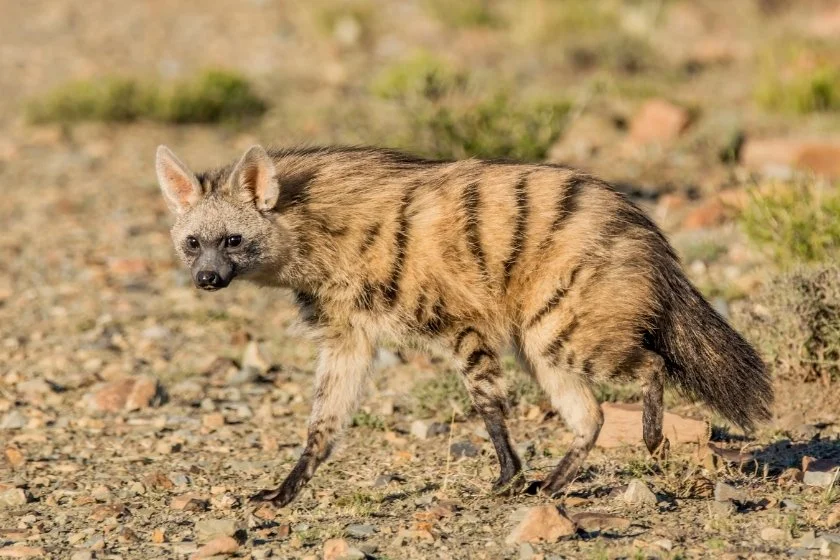
- Scientific name: Proteles cristata
- Classification: Mammalia
- Habitat: Semi-arid, Open plains, Savannas, and Grasslands
- Diet: Insectivore
- Where found: Southern and Eastern Africa
The Aardwolf looks similar to the striped hyena, but it has a smaller muzzle, a coat with brown-yellowish fur, a growth of long hair down the midline of its neck and back, and vertical black stripes.
These stripes are between 5 to 7 and run downwards from their back to their legs.
The stripes on these nocturnal animals serve as camouflage, making it difficult for predators (like lions, hyenas, and leopards) to spot them in the wild.
2. African Wild Ass
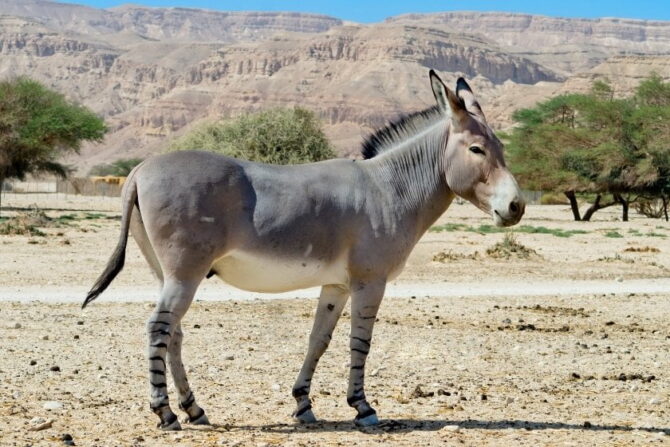
- Scientific name: Equus Africanus
- Classification: Mammalia
- Habitat: Arid/dry and semi-arid bushland and Grassland
- Diet: Herbivore
- Where found: Eritrea, Ethiopia, Somalia, and the Horn of Africa
African wild ass is also referred to as the African wild donkey and was turned into a domesticated species 6,000 years ago. They are the biggest wild ass in the world.
A light-brown colored coat on their body and black horizontal stripes on their limbs is what characterize them. They also live in a herd of about 100 animals.
Over the years, humans have captured these animals in their habitat.
While some are domesticated, others are interbred with domestic animals, reducing their numbers.
This reduction poses a population threat, and the International Union for Conservation of Nature (IUCN) Red List now classifies the African wild ass donkey as “Critically Endangered.”
3. Badgers

- Scientific name: Meles meles
- Classification: Mammalia
- Habitat: Dry and open grasslands, Woods, Quarries, Hedgerows, Sea cliffs, and Moorland
- Diet: Omnivore
- Where found: North America & Europe
Badgers have sharp claws and long limbs; they are nocturnal and easily adapt to a new environment.
They have gray-colored coats, dark faces, and a visible white stripe from their nose to their backs.
Most badger species are social creatures living in clans or setts, and each family behaves uniquely.
They are good with speeds, running as fast as 16 to 19 miles per hour.
Badgers do not hibernate until the coldest period in winter, and they sleep for a few days or weeks.
4. Bongo

- Scientific name: Tragelaphus eurycerus
- Classification: Mammalia
- Habitat: Rainforest
- Diet: Herbivore
- Where found: Africa’s dense forest
The Bongos are the third-largest antelope species in the world and have a reddish-brown coat.
They are part of the Tragelaphus, where both male and female species have horns. Both sexes also have stripes, which can be about 10–15 white stripes.
Once they feel threatened, they flee immediately and disappear into the surrounding forest, and this white stripe enables them to camouflage successfully within their habitat.
The bongos are on the “Lower Risk or Near Threatened” IUCN’s Red List.
5. Bumblebee

- Scientific name: Bombus
- Classification: Insecta
- Habitat: Temperate Climates
- Diet: Herbivore
- Where found: South America and New Zealand
Bumblebees are easy to identify because of their yellow and black stripes and are the commonest species of bees.
These insects possess four wings, which they use for flight, and are quite small compared to their total body size.
This feature led to a misconception that these species are incapable of flight.
The queen bee leads the bumblebees; they are organized and disciplined. They raise their young ones together and share the labor among themselves to promote the overall survival of their colony.
These features make them unique from other bees, while the stripe serves as protection, warning predators that they can sting.
The bumblebee is currently on the list of near-threatened species.
6. Clownfish
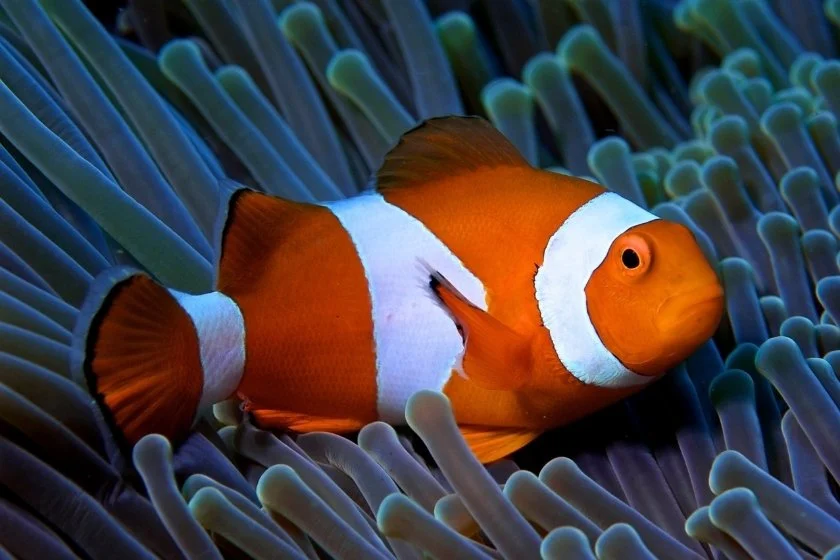
- Scientific name: Amphiprioninae
- Classification: Actinopterygii
- Habitat: Lagoons, Red sea, Indian ocean Pacific Ocean and around the anemone
- Diet: Omnivorous
- Where found: Japan, Indo-Malaysian region, and Southeast Asia
Clownfish is one of the most prevalent aquarium fish.
All clown fishes are hermaphrodites and can change their sex from male to female, but this process is irreversible.
Their features include an orange-reddish color with three visible white vertical stripes close to their eyes, middle of their body, and tail.
Although the stripes make them beautiful along with their orange color, it also helps them camouflage under the sea anemone.
7. Coral Snake

- Scientific name: Micrurus lemniscatus
- Classification: Reptilia
- Habitat: Pine and Scrub oak Sandhill, Hardwood areas, and Pine Flatwoods
- Diet: Carnivore
- Where found: North Carolina, Louisiana, and Florida
Coral snakes are small, covert, and light-colored venomous snakes of the cobra family, Elapidae.
Coral snakes have one of the most potent neurotoxic venoms. Most of their species are tricolored, combining red, black, and yellow colors.
They have smooth scales, short tails, and a short fang for spotting neurotoxic venom.
Their stipe pattern can serve as a warning signal to predators to avoid them due to their venomous bite.
This snake species are rare and are on the list of endangered species.
8. Threebar Dascyllus
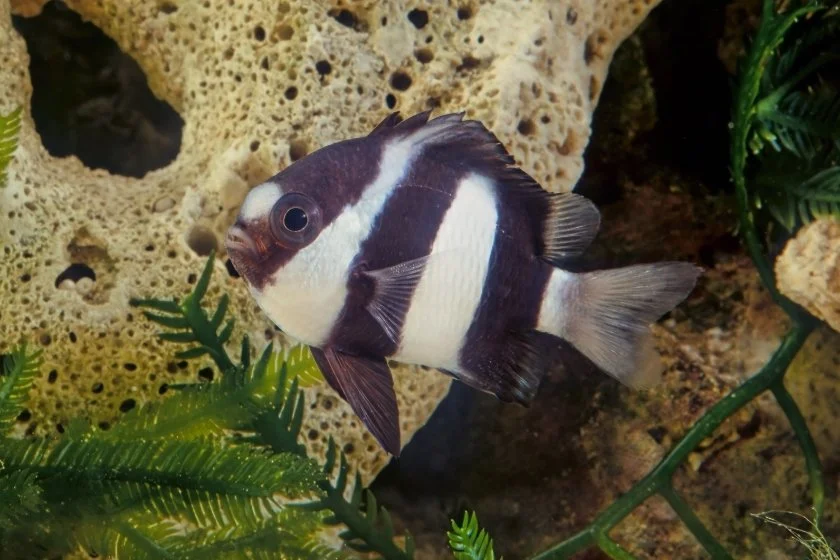
- Scientific name: Dascyllus aruanus
- Classification: Actinopterygii
- Habitat: Red sea, East coast of Africa, Ryuku Islands, Lord Howe Islands, and New South Wales
- Diet: Omnivore
- Where found: Red Sea, Eastern Africa, Australia, and Japan
Dascyllus are damsel fish species with a black stripe on their body.
They form communal relationships with the anemones for protection.
The Dascyllus rarely survive in an aquarium because they are generally wild and territorial and can cause a lot of destruction.
Although they are shy around humans, they make great pets for those who can tame them.
9. Eastern Chipmunk

- Scientific name: Tamias striatus
- Classification: Mammalia
- Habitat: Deciduous forests and Forest edges
- Diet: Omnivores
- Where found: Southern Canada, Northern America, and Mexico.
The eastern chipmunks are striped squirrels, or chippers, with a physical appearance similar to a squirrel. But the difference is that the squirrels have no stripes.
The eastern chipmunk possesses reddish-brown fur on their upper body that runs down their back and a lighter fur that starts on their ears across their belly.
They have about five dark-brown horizontal stripes with light brown stripes.
The stripes protect them while running through the forest, and the dark-brown tones of their fur make it easy to disappear among the trees and shrubs.
10. Ferrets

- Scientific name: Mustela putorius furo
- Classification: Mammal
- Habitat: Grasslands
- Diet: Carnivore
- Where found: North America, Europe, and Asia
The ferrets are small, weasel-like, and either has a brown or black color with a white stripe that runs down their back.
Most ferrets are illegally domesticated, while the wild ferrets (also called black-footed ferrets) are very rare. Wild species are considered endangered by the IUCN.
11. Four Stripe Damselfish

- Scientific name: Dascyllus melanurus
- Classification: Actinopterygii
- Habitat: Lagoons, Inlets, and Harbors
- Diet: Omnivore
- Where found: New Guinea, Philippines, and Indonesia
Four stripe damselfish is a popular marine fish species with black and white stripes. As their name implies, they have four white and black vertical stripes.
They are known to alternate the black and white stripes and have a visible triangular anal fin.
Their distinctive feature is their attractive color, which can captivate an aquarist’s attention for hours.
The black and white stripes help them (especially the young ones) camouflage in the sunlight shadows from the sea floor or coral reefs.
12. Garter Snake
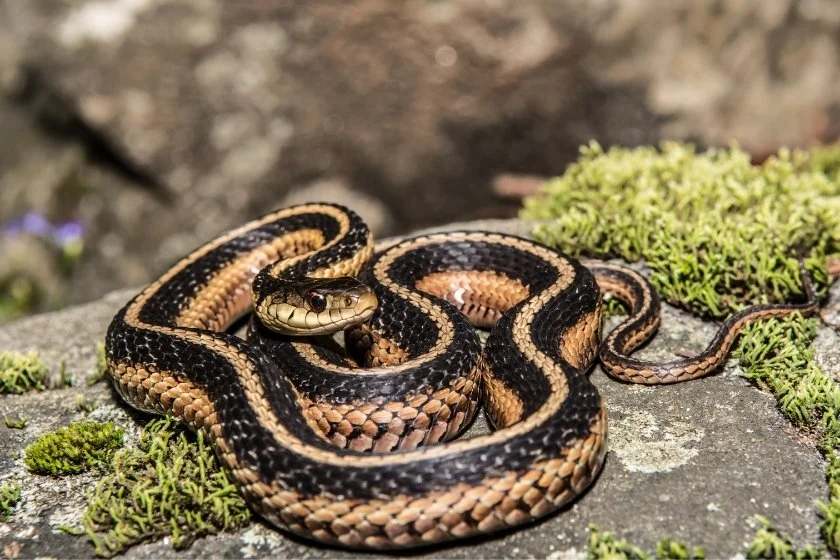
- Scientific name: Thamnophis sirtalis
- Classification: Reptilia
- Habitat: Forests, Fields, Streams, Wetlands, Meadows, Marshes, and Ponds
- Diet: Carnivore
- Where found: Canada, United States, and New Mexico
Garter snakes can be black, brown, or green with yellow stripes. They are species of Natricine snakes.
Their distinctive feature is their ability to twist their bodies into defensive postures compared to other snake species and give birth to 10 to 40 independent baby snakes.
Another outstanding feature is their ability to regenerate toxins from poisonous animals.
This feature is responsible for their ability to survive in the wild, where their average lifespan is five years.
13. Giant Elands

- Scientific name: Taurotragus derbianus
- Classification: Mammal
- Habitat: Woodlands, Broad-leafed Savanna, Fringes of deserts and forests
- Diet: Herbivore
- Where found: Western Africa, North America, and Asia
The giant elands are giant antelope with beautiful long reddish-brown fur and white stripes running down their sides.
They are currently the world’s largest antelope species and live in herds.
The male species grow double the size of the female species, and their color is darker.
Giant elands can be domesticated, and they have many advantages compared to domestic cattle because they can survive with little water and eat poisonous plants that can kill cattle.
14. Grandidier’s Mongoose

- Scientific name: Galidictis grandidieri
- Classification: Mammalia
- Habitat: Forest and Vegetation
- Diet: Carnivorous
- Where found: Madagascar
Grandidier’s mongoose is sometimes known as the Giant-striped mongoose or Grandidier’s vontsira because of its larger size compared to other Malagasy mongooses. It was named after researcher Alfred Grandidier.
It is a small-sized animal having a brown-greyish-colored coat. It has about eight dark-colored stripes on its back and the sides of its body.
The fur and the black stipe contribute to their ability to camouflage perfectly in their environment.
15. Greater Kudu
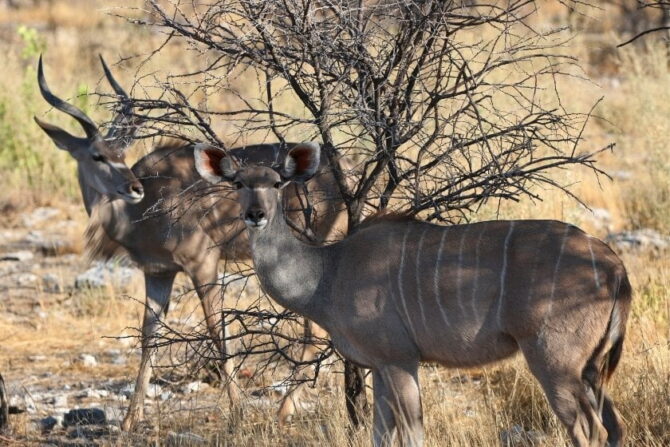
- Scientific name: Tragelaphus strepsiceros
- Classification: Mammalia
- Habitat: Scrub woodlands, Degraded pastures, and Mopane bush.
- Diet: Herbivore
- Where found: Eastern and Northern Africa
The greater kudu is one of the tallest antelopes; it has a brown-reddish coat and 12 vertical white stripes on its torso.
The colored coat on its head is darker than the rest of its body. It also possesses white-colored stretches around its eyes.
The combination of its color (reddish-brown coat) and white stripes is responsible for its ability to camouflage in its environment.
16. Hog-nosed Skunk

- Scientific name: Conepatus semistriatus
- Classification: Mammalia
- Habitat: Grasslands, Rocky terrains and Desert scrub, Pine-oak forests
- Diet: Omnivore
- Where found: Central and North America
The hog-nosed skunk is one of the largest skunks in the world and has a single, broad white stripe from its head to its tail.
It has stocky legs, wide hind feet, and long fore claws; the males are bigger than the females.
The hog-nose skunks live a lonely life, are nocturnal, and only socialize during their breeding season.
Their acute sense of smell makes their hunting easy in capturing buried prey. They also secret a foul-smelling musk to deter predators.
17. Indian Palm Squirrel
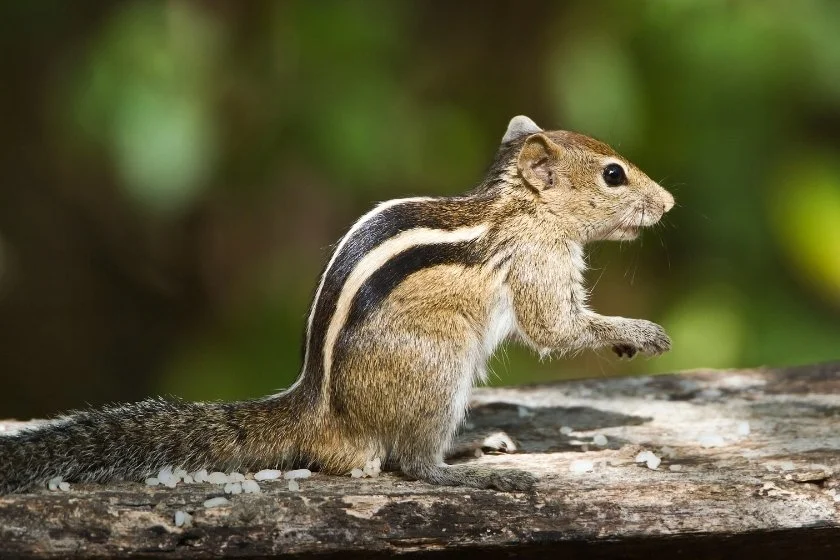
- Scientific name: Funambulus palmarum
- Classification: Mammalia
- Habitat: Mangrove forest, Tropical dry forest, Rainforests, Grasslands, Scrubs, Parks, and Gardens
- Diet: Omnivore
- Where found: India and Sri Lanka
Indian palm squirrel has grey-brown fur with three white stripes on their backs, which extends from their head to their tails.
They are different from other squirrels because they do not hibernate and have the same physical features as the chipmunks due to their similar stripes.
These animals are sacred in India, and they believe that the white stripes of the Indian palm squirrel are from the marks of the fingers of Lord Rama.
18. Juvenile Tapir

- Scientific name: Tapirus marbious
- Classification: Mammal
- Habitat: Woodlands, Grasslands, Mountains, and Rainforest
- Diet: Herbivore
- Where found: Central and South America, Southeastern Asia, Mexico, Sumatra, Malaya, Thailand, Brazil, and Paraguay
The juvenile tapir has a dark brown colored coat all over its body accompanied by white horizontal stripes.
In contrast, the adult tapir has a reddish-brown colored coat but with little or no white stripes.
The stripes in the juvenile tapir’s body help camouflage in their environments as they often hide in water and poop in the water to prevent the predators from detecting their scents.
19. King Cheetah
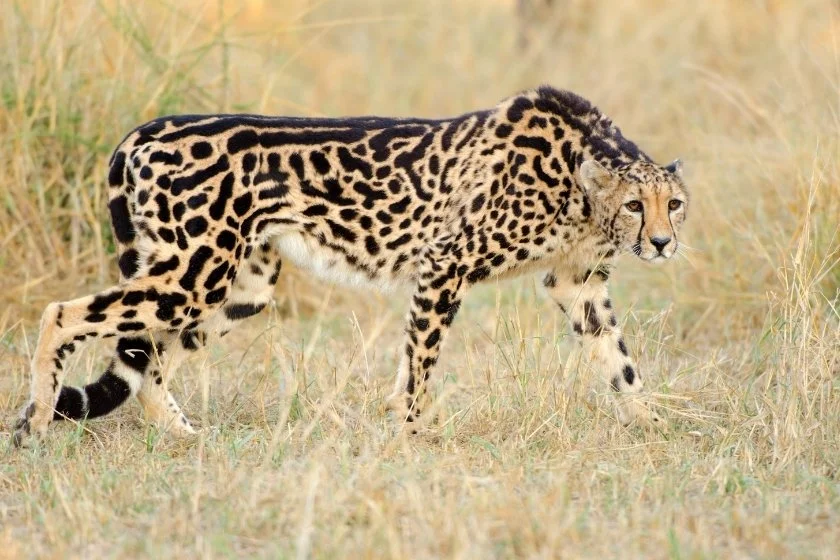
- Scientific name: Acinonyx jubatus
- Classification: Mammalia
- Habitat: Grassy plains and Flatlands
- Diet: Carnivore
- Where found: South Africa
King cheetah is a rare breed from the regular cheetah and has distinctive features.
Scientists have rescinded their previous hypotheses and verified that the King cheetah is not a different specie but a variation of the cheetah species.
King cheetahs have an irregular blotchy spot with three unique vertical stripes down their back.
This stripe gives them their distinctive feature, which is also a recessive trait.
Since these species are rare, less than 50 are left in the world, and the parks and wildlife conversations protect them.
The average lifespan of the king cheetah is 15 to 20 years, and the biggest threat to these species is humans.
20. Larger Pacific Striped Octopus
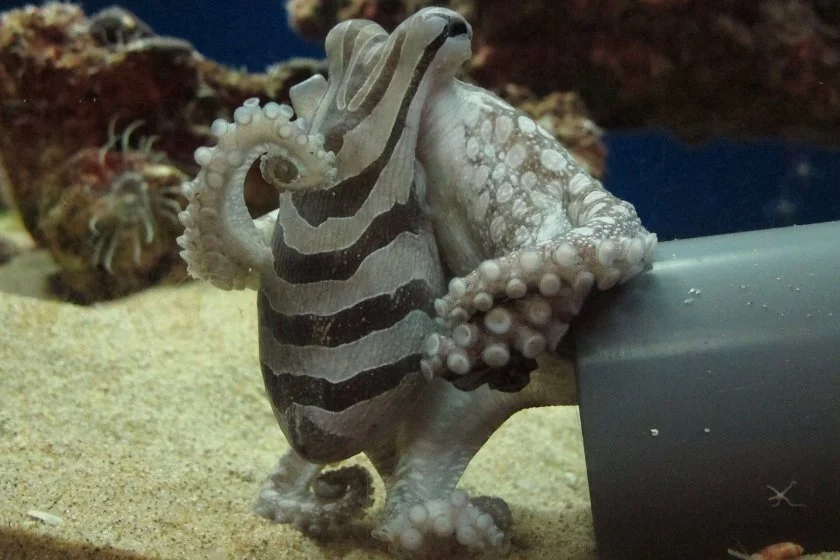
- Scientific name: Octopus sp
- Classification: Cephalopoda
- Habitat: Eastern Pacific waters
- Diet: Carnivore
- Where found: Panama, Guatemala, Magdelena Bay in Mexico, The northern pacific coast of Colombia, and Nicaragua
The larger Pacific striped octopus is often known as the Harlequin octopus and is a rare species of octopus widely known for its social nature.
They have brown and white stripes on their head, mantle and arms.
These species form a colony of up to 40 striped octopuses and construct dens close to each other.
The larger pacific striped octopus goes through a senescence stage, marking the near approach of death.
After the first senescence signs, the male species last 1 to 2 weeks while the female species last between 2 to 4 months.
21. Lesser Kudu
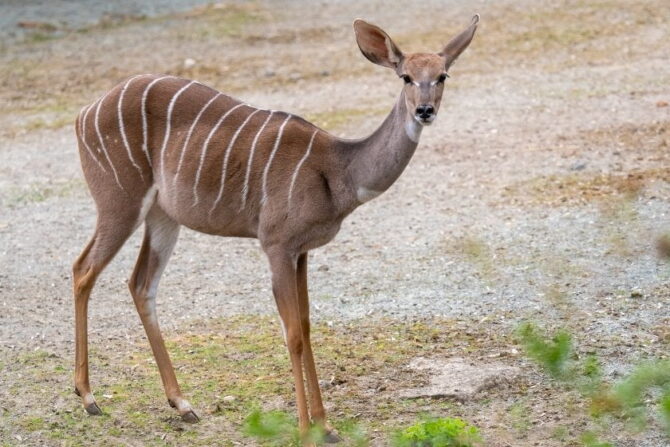
- Scientific name: Tragelaphus imberbis
- Classification: Mammal
- Habitat: Scrublands and Woodlands
- Diet: Herbivore
- Where found: Northeastern Africa
The lesser kudus are antelopes with long curved horns. They have dark vertical stripes on their sides and are not territorial.
They are timid animals and do not interact except when feeding with other animals in their exact location.
They hunt at night and dawn and spend their midday ruminating in shaded areas.
Their shyness and ability to camouflage with their stripes protect them from poaching risks.
22. Lowland Bongo
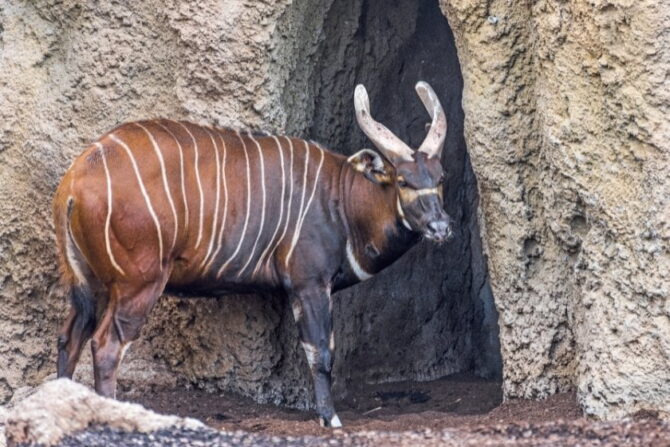
- Scientific name: Tragelaphus eurycerus
- Classification: Mammal
- Habitat: Lowland Rainforest
- Diet: Herbivore
- Where found: Western Africa, Congo basin, and Southwestern Sudan
They are the largest African forest antelopes.
The bongos are Tragelaphus, in which both sexes have horns; the difference is that the male horns are bigger.
They possess two long black stripes, which run down their backs, and white stripes on their sides.
The conservation status of the lowland bongo is “Near Threatened,” as described by the IUCN.
23. Mackerel Tabby Cat
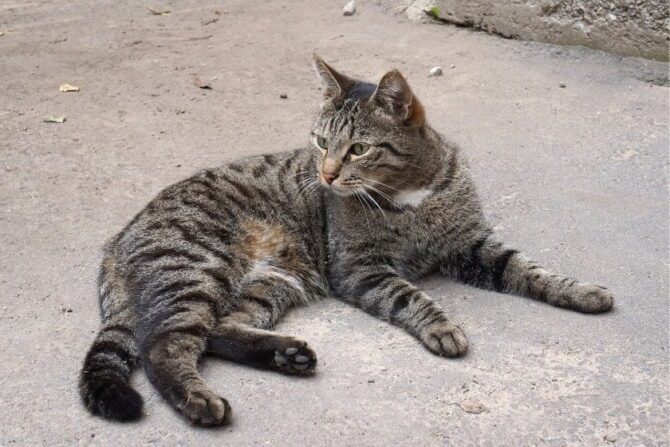
- Scientific name: Felis catus
- Classification: Mammalia
- Habitat: Rural areas
- Diet: Carnivores
- Where found: All continents except Antarctica
The mackerel tabby cat is the only striped domestic cat. It has long, thin and black stripes on its sides and stomach.
Its distinctive feature is the “M” shape of black fur on its forehead, and its name is gotten from the mackerel fish because of its similarities to the fish’s skeleton.
24. Moorish Idol Fish
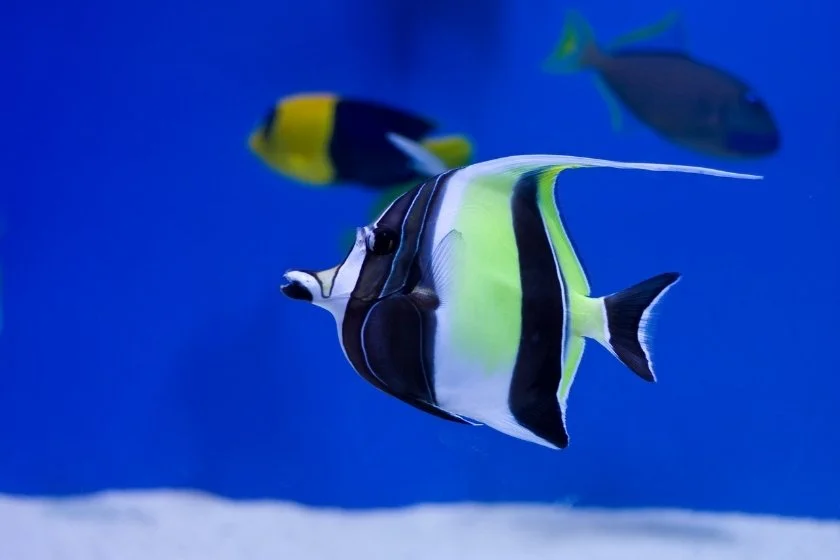
- Scientific name: Zanclus cornutus
- Classification: Actinopterygii
- Habitat: Red sea, Indian Ocean, Pacific Ocean, and Oceans of Africa
- Diet: Omnivores
- Where found: Japan, New Zealand, Peru, and Golf of California
Moorish idols possess black, white, and yellow stripes, which add to their beauty.
They rarely survive in an aquarium because they are picky eaters and would rather starve than eat what is available.
Their name is derived from the Moors of North Africa, who believed that these fishes bring happiness.
25. Mountain Nyala

- Scientific name: Tragelaphus buxtoni
- Classification: Mammal
- Habitat: Mountain woodland
- Diet: Herbivore
- Where found: Central Ethiopia, Eastern, and Southern Africa
Mountain Nyala has a brown coat with white stripes that extends from the back to its underside.
The white stripes are also on their face, throat, and legs. They are shy to humans and move in a small herd (4 to 5 nyalas).
They have a distinctive stripe coat that serves as camouflage to blend with their surroundings.
Recent research suggests that mountain nyalas are considered endangered species.
26. Numbat

- Scientific name: Myrmecobius fasciatus
- Classification: Mammalia
- Habitat: Woodlands and Forests
- Diet: Insectivore
- Where found: Southern and Western Australia
Numbat, also known as the banded anteater, live in small groups with their young ones and have slender bodies with large bushy tails.
They have a distinct reddish-brown fur and a white stripe across their lower back and tail.
This distinctive feature helps them camouflage in their habitats, especially in the woodlands.
This feature makes them invisible while hunting insects (termites) with erected tails.
With less than 1,000 numbats left, researchers have placed this species on the red list.
27. Okapi
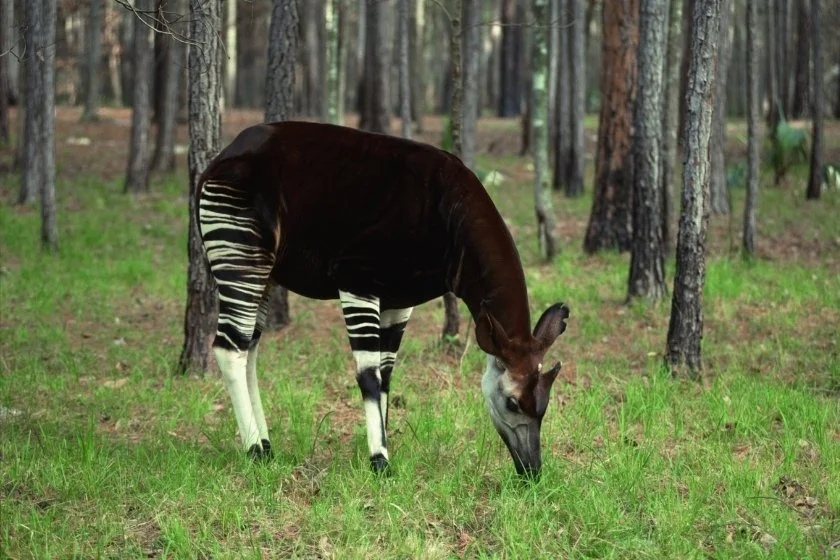
- Scientific name: Okapia johnstoni
- Classification: Mammalia
- Habitat: Tropical rainforest
- Diet: Herbivores
- Where found: Africa and the Democratic Republic of Congo.
Okapi is often confused with zebra because of their similar back stripes.
These mammals have a white horizontal stripe on their back and white stripe rings on their legs, ankles, and furs.
The combination of the white stripe with their color (chocolate reddish-brown) enables them to camouflage in dense vegetation.
The stripes are similar to the sun filtering through the forests and fade successfully into shadows to hide from predators.
The stripes also help the young okapi locate their mothers in dense rainforests since they are at a calf’s eye level.
28. Raccoon

- Scientific name: Procyon lotor
- Classification: Mammal
- Habitat: Trees and Caves
- Diet: Omnivore
- Where found: Northern and Central America, Europe, and Japan
Raccoons are the largest of the family procyonid and have a greyish coat consisting of a dense underfur; this underfur insulates the raccoon’s body during cold weather.
What distinguishes the raccoon is a black mask of fur that covers its eyes.
Although raccoons look cute and cuddly, they can be wild when they feel threatened.
Raccoons are nocturnal animals and sleep during the daytime, but during winter, they sleep more often; therefore, they do not hibernate.
Raccoons are common carriers of roundworms, rabies, and leptospirosis, so scientists do not recommend raccoons as pets.
29. Ring-Tailed Lemur
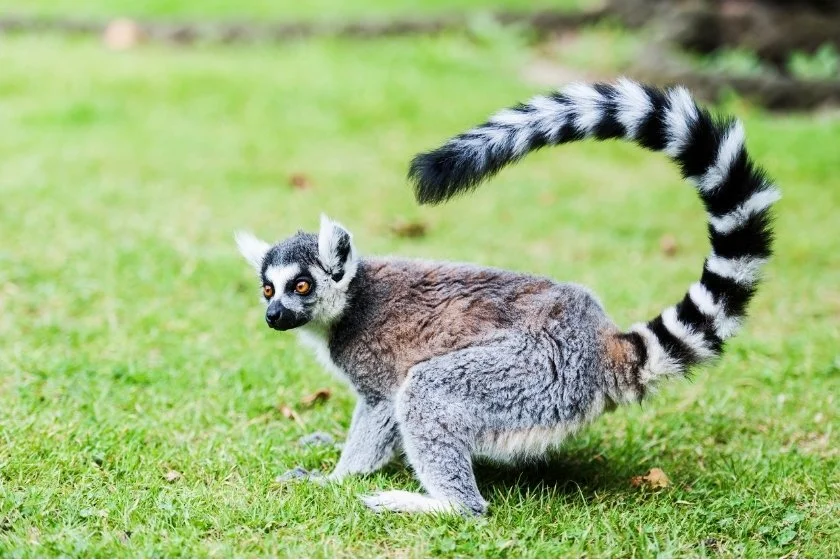
- Scientific name: Lemur catta
- Classification: Mammal
- Habitat: Deciduous forests
- Diet: Herbivore
- Where found: Madagascar
Ring-tailed lemurs are one of the lemur species and are easy to identify.
As their name implies, ring-tailed lemurs have long tails with black and white rings and are very territorial.
They live in troops (consisting of 6 to 30 lemurs), and their black stripe is for communication and a weapon against other lemurs.
The ring-tailed lemur is currently the world’s most endangered mammal due to the illegal pet trade.
In a recent assessment by the IUCN, it was found that there are about 98% of endangered lemur species, while 31% are critically endangered.
30. Scottish Wildcat

- Scientific name: Felis silvestris
- Classification: Mammal
- Habitat: Savanna, Open forest
- Diet: Carnivore
- Where found: Britain, Scotland, Southern and Northern England
The Scottish wildcat is similar in physical appearance to the domestic tabby cat, but it has more stripes and a bushier tail.
This species has a greyish-brown color with dark stripes. It is reserved, lives an isolated life, and has an average life span of about 11 to 12 years.
The Scottish wild cats are active only during dawn and dusk.
This wildcat is critically endangered; therefore, the Nature agency established the Wildcat Conservation Action Plan to protect critically endangered wildcat species.
31. Striped Bass

- Scientific name: Morone saxatilis
- Classification: Actinopterygii
- Habitat: Fresh water and Saltwater
- Diet: Carnivore
- Where found: North America, Mexico, South Africa, Turkey, Russia, Iran, and Latvia
The striped bass has a visible olive green color with a bluish touch.
It has a silver body, golden eyes, and narrow vertical stripes of about 7 to 8 from its gill to its tail.
The female striped bass grows larger than their male counterparts.
Their distinct feature from the other fish tribe is their upper jaw bones sheathed by the pre-orbital bone.
Recent research has shown that the striped bass is fished for recreational purposes and subject to overfishing.
32. Striped Hyena

- Scientific name: Hyaena hyaena
- Classification: Mammalia
- Habitat: Deserts/semi-deserts, Woodlands, Scrub forests, Acacia, Grasslands, Rocky terrains, and Tropical terrains.
- Diet: Omnivores
- Where found: India, Asia, Caucasus, Eastern, and Northern Africa.
The striped hyena is among the most exciting animals in Africa because of its loud laughter-like call and striped coat; this feature makes it unique.
They have a grey color coat with dark vertical stripes on their body.
Both male and female striped hyenas are similar in physical looks, but the males are usually a bit larger.
A striped hyena’s fur does not have an underfur to keep them warm in winter, but it is a good adaptation for the hot summer.
33. Striped Marlin

- Scientific name: Kajikia audax
- Classification: Actinopterygii
- Habitat: Tropical or temperate waters of the Pacific and the Indian Ocean
- Diet: Carnivore
- Where found: Pacific and the Indian Ocean
The Striped marlins are one of the biggest fish in the ocean, and they aren’t easy to catch.
Their physical features are dark blue backs and silver bellies. They have light blue and light purple stripes.
Their distinct feature is their ability to change the color of their stripes when excited, especially during feeding or mating.
Humans hunt these species for recreation and consumption.
The IUCN recently added them to the European RedList because their numbers have reduced drastically.
34. Striped Pyjama Squid

- Scientific name: Sepioloidea lineolata
- Classification: Cephalopoda
- Habitat: Indo-Pacific Oceans
- Diet: Carnivore
- Where found: Australia
The striped pyjama squid is a cuttlefish species with white and black stripes all over its body.
It is generally known for its poisonous cephalopods because of the toxic slime it releases from the small glands under its body.
The white stripes reflect white light, while the brown stripes are chromatophores.
When threatened, the striped pyjama squid starts a display of color and pattern changes. The black stripes act as a warning to potential predators.
Although commercial fishing does not threaten the striped pyjama squid, their shallow coastal habitat is vulnerable to human impact.
35. Striped Skunk
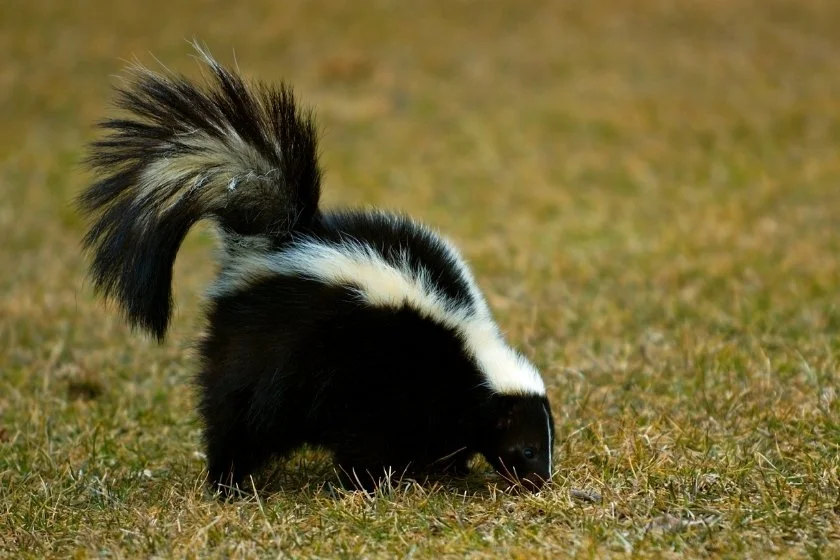
- Scientific name: Mephitis mephitis
- Classification: Mammalia
- Habitat: Woodlands, Deserts, Urban and Suburban environment
- Diet: Insectivore(during spring and summer) and Carnivore (during colder months)
- Where found: Southern and central Canada, Northern Mexico, and North America
The striped skunk has white striped fur. The white stripes start from their head and split into two parallel stripes stretching to their tail.
This extension is parallel to each other and also similar to their bodies.
The stripes act as camouflage from predators during the hunt for their prey.
36. Thirteen-lined Ground Squirrel
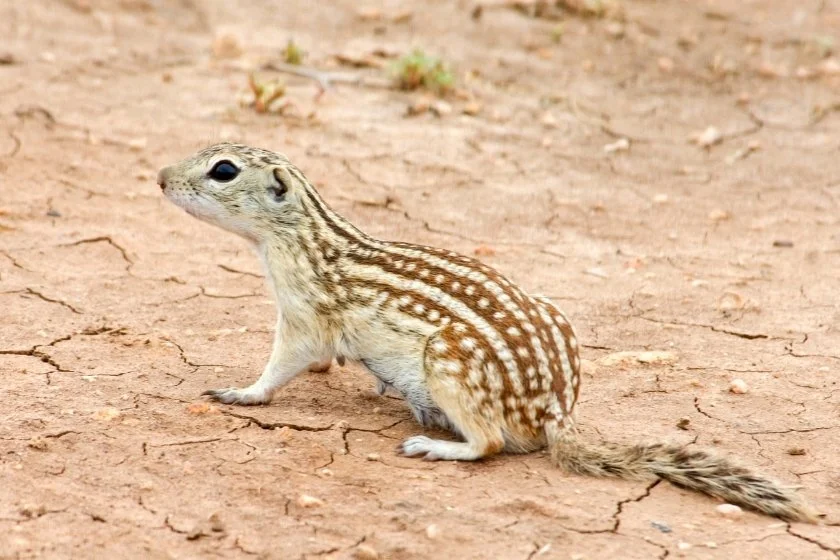
- Scientific name: Ictidomys tridecemlineatus
- Classification: Mammal
- Habitat: Mowed lawns, golf courses, grazed pastures, and parks
- Diet: Herbivore
- Where found: North America and Canada
As their name implies, thirteen-lined squirrels have thirteen white and black alternating stripes on their backs.
They are small, have tiny ears and thin bushy tails, and are very active on midday or sunny days.
They have a good sense of smell, touch, and vision. These squirrels communicate with other members through alarm calls, noises, and scented secretions.
Predators usually take over 90% of their young ones before the start of their hibernation, and once they reach the adult stage, they only live for a few years.
They have a life span of 7 to 9 years and are good at outrunning and hiding perfectly from predators.
37. Tiger

- Scientific name: Panthera tigris
- Classification: Mammalia
- Habitat: Temperate forests, Tropical forests, and the Indian subcontinent
- Diet: Carnivore
- Where found: Russia, Vietnam, Malaysia, Indonesia, China, India, Bangladesh, Nepal, Cambodia, Bhutan, Myanmar, and Laos
Tigers have a brown-white colored coat with black vertical stripes on them.
These stripes and patterns are unique to each tiger (no two tigers can have the same stripes).
The combination of its brown fur and black stripes mimics the fallen sunlight in the forest, and this helps them to camouflage well, especially when hunting their prey at night.
A distinctive feature of the tigers is their ability to blend into different environments easily.
The tigers are currently on the list of endangered animals.
38. Watty Pig

- Scientific name: Sus cebifrons
- Classification: Mammal
- Habitat: Dense forest areas and Grasslands.
- Diet: Omnivore
- Where found: Asia and South Africa
Watty pigs are little forest-dwelling pigs. The males are often known as boars and are larger, while the females are smaller and known as sows.
They live together in packs and are not territorial.
The name “Watty” comes from their habitat and the three warts on their faces.
Warts help to protect their face during a fight with other animals or predators.
39. Zebra

- Scientific name: Equus quagga
- Classification: Mammalia
- Habitat: Treeless grasslands and Savanna woodlands
- Diet: Herbivores
- Where found: Eastern and Southern Africa, Northern Kenya, Namibia, Angola, and Ethiopia
The physical features of the zebra are visible black and white stripes.
The zebra stripes are unique; no two zebras can have the same stripes by location, thickness, darkness, and length.
In zebra, the stripes play many roles, such as:
- Acting as sunscreen
- Being unattractive to flies that spread diseases
- Creating an optical illusion that confuses the predators; they believe that the zebra is moving in one direction when it is moving in another.
40. Zorse

- Scientific name: Equus zebra x Equuscaballus
- Classification: Mammalia
- Habitat: Open grasslands and woodland
- Diet: Herbivores
- Where found: Open Grassland and woodlands of Africa
Zorse is the young from the crossing of a zebra and horse. They have white and stripe patches gotten from their parents.
Their distinctive feature is the presence of unique dark stripes, which are more visible on their legs and other areas like their head and neck.
The zebra features of the zorse make it resistant to certain pests that affect horses and donkeys, and their sizes vary based on their parents’ features.
Conclusion
All 40 examples of animals with stripes explained in detail above show how these creatures use their stripes to protect themselves from predators and to hunt prey, thus, confirming the scientists’ stripe theory.
For these striped animals, it is harder for predators and prey to spot them in their natural habitats.






